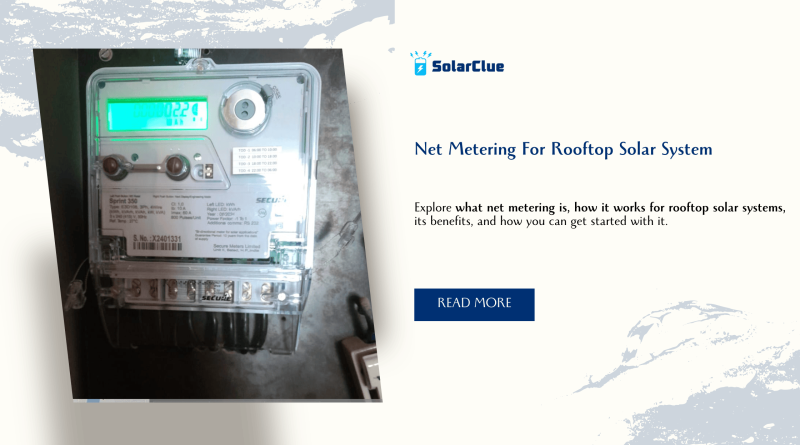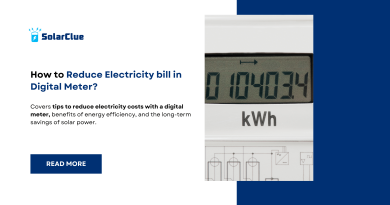Net Metering For Rooftop Solar System
As solar power becomes a popular and sustainable energy choice in India, net metering has emerged as one of the most effective ways to encourage the adoption of rooftop solar systems. Net metering allows consumers to generate their own electricity through solar panels and reduce their electricity bills by sending excess energy back to the grid. It’s a win-win for both consumers and the environment, promoting cleaner energy while offering financial benefits.
In this blog, we’ll explain what net metering is, how it works for rooftop solar systems, its benefits, and how you can get started with it.
Table of Contents
What is Net Metering?
Net metering is a billing mechanism that allows consumers to generate their own electricity (typically through solar panels) and connect to the local grid. When your solar panels generate more electricity than you need, the excess power is sent to the grid, and you are credited for this energy. These credits can be used to offset the electricity you consume from the grid when your system isn’t producing enough power, such as during nighttime or cloudy days.
Simply put, net metering enables you to “store” your excess electricity on the grid and use it later, effectively reducing your electricity bills.
How Does Net Metering Work for Rooftop Solar Systems?
Net metering is a straightforward process, but it requires specific infrastructure and policies in place. Here’s how it works step by step:
1. Solar Panels Generate Electricity
Solar panels installed on your rooftop convert sunlight into electricity. This electricity powers your home or business, reducing the need to purchase energy from the grid.
2. Excess Electricity is Exported to the Grid
If your solar panels produce more electricity than your consumption at any given moment (for example, during peak sunlight hours when no one is home), the surplus power is automatically exported to the grid through a bi-directional meter. This meter tracks both the electricity you consume from the grid and the electricity you send back.
3. You Earn Credits for Excess Energy
For every unit of electricity you send to the grid, your utility company provides you with credits. These credits are applied to your electricity bill, reducing your overall cost. If you generate more electricity than you consume over a billing period, the credits can be carried forward to future months.
4. Importing Energy When Needed
At night or during low sunlight conditions, your solar panels might not produce enough energy to meet your needs. In this case, you will draw electricity from the grid, but the credits you earned from the excess energy exported earlier can offset this cost.
Key Benefits of Net Metering for Rooftop Solar Systems
1. Reduced Electricity Bills
One of the main advantages of net metering is the significant reduction in electricity bills. By using the energy you generate, and earning credits for the surplus energy you export to the grid, you can drastically reduce your electricity consumption from the grid, resulting in lower energy costs.
2. Maximized Use of Solar Energy
Net metering allows you to maximize the use of solar power by ensuring that none of the energy you generate goes to waste. When your solar system produces excess electricity, it is sent back to the grid for future use, helping you optimize the return on your investment.
3. Quick Payback Period
Thanks to net metering, consumers can recover the cost of their rooftop solar systems faster. The combination of reduced electricity bills and government incentives (like subsidies) often results in a payback period of 5-7 years, after which the solar system generates free electricity for up to 20 years or more.
4. Environmental Impact
By generating and using solar energy, consumers can reduce their carbon footprint. Net metering encourages the use of clean, renewable energy, helping reduce greenhouse gas emissions and combat climate change.
5. Energy Independence
Net metering gives consumers greater energy independence by allowing them to rely less on the grid. This is particularly beneficial in regions with unreliable power supply, as the solar system can provide a more consistent and sustainable energy source.
Net Metering Policies in India
In India, the Ministry of New and Renewable Energy (MNRE) has been instrumental in promoting solar energy and net metering. Each state has its own regulations and policies for net metering, and the specifics can vary depending on where you live.
General Guidelines for Net Metering in India:
1. System Size: Most states allow rooftop solar systems ranging from 1 kW to 1 MW under net metering.
2. Bi-Directional Meter: A bi-directional meter is required to measure both energy consumption from the grid and energy export to the grid.
3. Credits and Settlement: Energy credits for excess power exported to the grid are typically settled monthly, and any excess credits can be carried forward to future billing cycles.
4. Capacity Limitations: Many states limit the capacity of solar systems to a certain percentage (typically 80-100% of the sanctioned load) of the consumer’s grid connection.
Example of Net Metering in States:
1. Delhi: In Delhi, rooftop solar systems up to 1 MW can participate in net metering. Consumers are credited for excess energy exported to the grid, and the credits are carried forward to the next billing cycle.
2. Maharashtra: Maharashtra’s net metering policy allows residential, commercial, and industrial consumers to install solar systems up to 1 MW, with the facility to offset electricity bills through net metering.
3. Tamil Nadu: Tamil Nadu offers net metering for both residential and commercial installations, allowing consumers to feed excess energy back to the grid and earn credits for future use.
Consumers should check their state’s specific net metering guidelines and incentives before installing a solar system.
Steps to Get Started with Net Metering for Rooftop Solar
1. Evaluate Your Energy Needs
Start by evaluating your household or business’s energy consumption to determine the appropriate size of the solar system you need. This will help you decide how much solar power you want to generate and whether you’ll be able to take full advantage of net metering.
2. Choose a Reputable Solar Installer
Select an approved solar vendor or installer to ensure that your system is designed and installed correctly. Reputable companies will be familiar with the net metering regulations in your state and will assist with the paperwork and application process.
3. Apply for Net Metering
Submit an application to your local distribution company for grid connectivity under net metering. The application process may vary by state, but your solar installer will typically handle this on your behalf.
4. Install a Bi-Directional Meter
A bi-directional meter is required to track the electricity you consume from the grid and the electricity you export. Your distribution company will approve the installation of the meter as part of the net metering setup.
5. Generate Solar Energy
Once your solar system is installed and connected to the grid, it will start generating electricity. Excess energy will automatically flow back to the grid, and you will begin earning credits to reduce your electricity bills.
Conclusion
Net metering for rooftop solar systems is an excellent way to maximize the financial and environmental benefits of solar energy. By allowing consumers to generate their own power, export excess energy to the grid, and earn credits, net metering can significantly reduce electricity bills and accelerate the payback period for solar investments.
As solar technology continues to advance and state policies evolve to encourage renewable energy, more consumers are adopting rooftop solar systems with net metering to power their homes and businesses sustainably.
Ready to Save on Electricity Bills with Solar Power?
With Net Metering, you can drastically reduce your electricity costs by generating your own solar power and sending any excess back to the grid. It’s time to harness the sun’s energy and make a positive impact on both your wallet and the environment!
At SolarClue, we make the transition to solar simple, efficient, and affordable. Whether you’re a homeowner, business, or institution, our team of solar experts will guide you through the process—from installation to maintenance—so you can start saving from day one.
🌞 Take the first step towards energy independence today!
🔋 Get your solar consultation now!
Contact SolarClue or call us at +91-888-4444-830 to explore the best solar solutions for your home or business.
Go Solar. Save More. Power Your Future with SolarClue!
FAQs
1. What is the difference between net metering and gross metering?
In net metering, consumers offset their electricity consumption with the solar energy they generate, and they are credited for any excess power exported to the grid. In gross metering, all the electricity generated by the solar system is exported to the grid, and consumers are paid for it at a fixed tariff while purchasing their electricity separately from the grid.
2. Can net metering eliminate my electricity bill?
Yes, in some cases, net metering can significantly reduce or eliminate your electricity bill if your solar system generates enough power to meet your consumption needs and export excess energy to the grid.
3. Is net metering available across all states in India?
While net metering is available in most states, the specific policies and regulations vary. It’s important to check the guidelines for your state.
4. What happens to the credits if I produce more energy than I consume?
Any excess energy credits are typically carried forward to the next billing cycle. In some states, credits may lapse at the end of the financial year.
5. How much does it cost to install a rooftop solar system with net metering?
The cost depends on the system size, equipment, and installation costs. Typically, a 1 kW system can cost between ₹40,000 and ₹60,000, and government subsidies may be available to reduce the cost.



